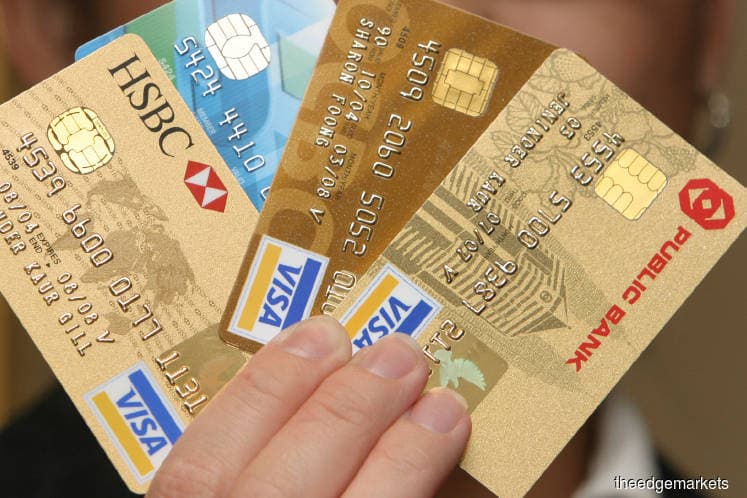
This article first appeared in The Edge Malaysia Weekly on March 9, 2020 - March 15, 2020
THE proliferation of e-wallets in the digital era does not appear to have cannibalised credit cards. In fact, demand for credit cards has grown in recent years.
Currently, there are more e-money issuers than there are credit card issuers. Bank Negara Malaysia’s website lists 44 non-bank and six bank e-money issuers while there are 27 credit card issuers.
According to Bank Negara data, principal credit cards in circulation increased from 7.2 million in January 2015 to 9.1 million in January this year. The volume of credit line extended increased from RM124 billion to RM151.8 billion. However, current balances only inched up from RM35 billion to RM38.9 billion.
In 2019, the number of credit card transactions stood at 510 million compared with 359.6 million in 2015. Total purchases using credit cards amounted to RM151.3 million versus RM118 million in 2015.
“We note the rise of e-wallet usage in Malaysia; however, credit cards remain the preferred payment tool for many. This is due to their high acceptance compared with e-wallets. OCBC cards registered annual credit card growth of close to 6% for the past three years,” says OCBC Bank (M) Bhd head of consumer lifestyle finance Ryan Kong.
Siew Yuen Tuck, CEO and co-founder of Jirnexu — a fintech aggregator of banking and insurance products — says data shows that the transaction volume of e-wallets is higher than credit cards but the value of transactions of the latter surpasses that of the former multifold. “Credit cards are still popular despite e-wallet issuers getting aggressive in their marketing in recent years. They both have their pros and cons,” he says.
Malayan Banking Bhd head of cards B Ravintharan believes credit cards will continue to be relevant in the digital age and complement e-wallets in the market. “Customers will still need credit cards for big-ticket item purchases. Credit cards provide the convenience of not having to carry a large amount of cash around. They are a form of cashless payment that was introduced to Malaysia some 40 years ago. Given that they are a more established form of cashless payment compared with e-wallets, consumers are more familiar with them … which explains the continued demand for these cards,” he says.
“In addition, credit card issuers have also been leveraging digitalisation to improve their offerings, such as enabling merchants to accept credit card payments from customers without requiring a point-of-sale terminal and enabling merchants who are on-the-go (such as salesmen and delivery personnel) to accept card payments via their mobile phones,” he adds.
Ravintharan also points to the strong adoption of contactless payment that is driven by speed, convenience and security. “In 2019, contactless payment captured half of the total face-to-face transactions recorded by Maybank, which is a more than 100% growth from 2018.”
He believes the convenience afforded by credit cards in e-commerce transactions has also fuelled the increase in the usage of credit cards. Last year, Maybank’s ecommerce billings grew 30%.
Are credit card holders shopping?
Credit card spending continues to be healthy, bankers observe.
“OCBC cards spending grew healthily in 2019, with the business achieving a record growth of 17% year on year, surpassing the industry’s 6% y-o-y growth,” says Kong.
He adds that OCBC’s average card spending per customer increased at a healthy 10%. He observes that the growth momentum was carried forward into January this year at the same rate.
“OCBC’s card spending comes primarily from insurance, shopping, utilities, travel, groceries and dining,” he says.
Despite the Covid-19 pandemic, Kong says the shopping category registered the highest percentage of y-o-y spending growth increase. “The primary category with a drop in spending was, unsurprisingly, travel.”
In the fourth quarter of 2019, OCBC’s card spending grew 20% y-o-y against the industry’s 9%. “Even though the pandemic became more critical in January, our spending still grew healthily at 17% year-on-year,” Kong reveals.
He admits that maintaining or growing the business this year will be a challenge, although 2019 was a positive year for OCBC cards, adding that it is a challenge that the business is prepared for and ready to embrace.
“We are gearing to innovate in terms of acquiring new customers while continuously engaging existing ones. The business would also have to focus on driving further growth for key spending categories that have been performing, while improving those that have not, through revolutionary products, marketing initiatives and services that fulfil our customers’ lifestyle requirements,” Kong says.
Over at Maybank, the credit card segment saw double-digit growth last year for merchants in the retail, health and beauty, direct marketing, education, entertainment and food and beverage categories. “We command over 31% market share for billings in the country and recorded 13% y-o-y growth in 2019,” Ravintharan says.
Save by subscribing to us for your print and/or digital copy.
P/S: The Edge is also available on Apple's AppStore and Androids' Google Play.